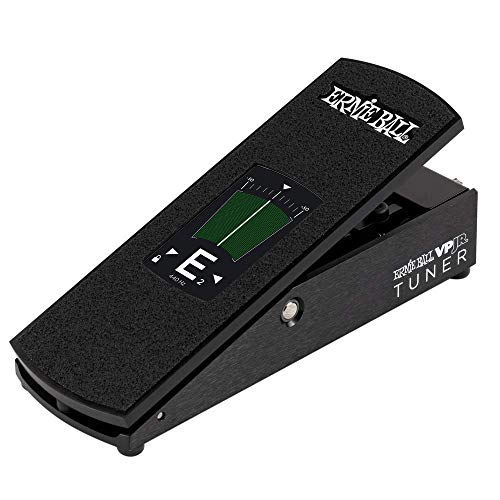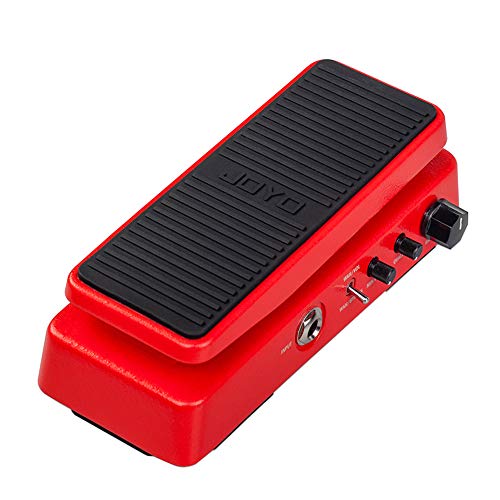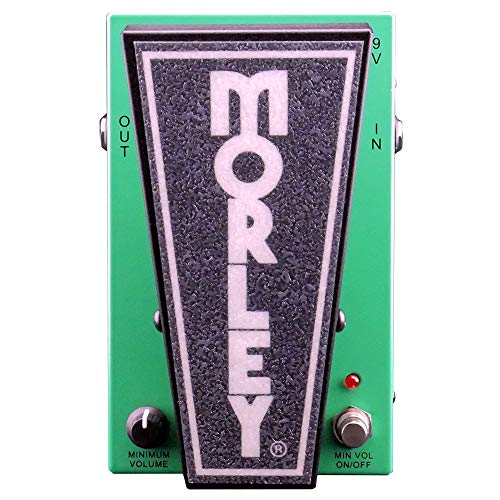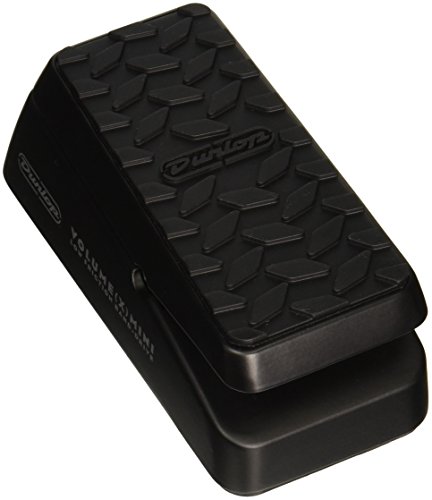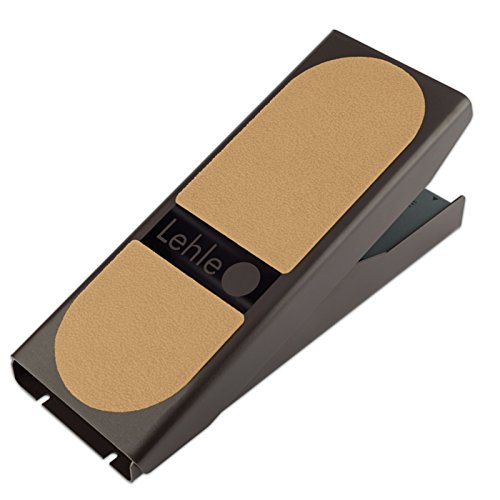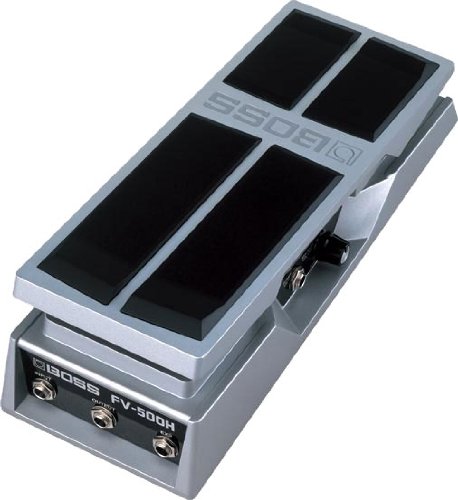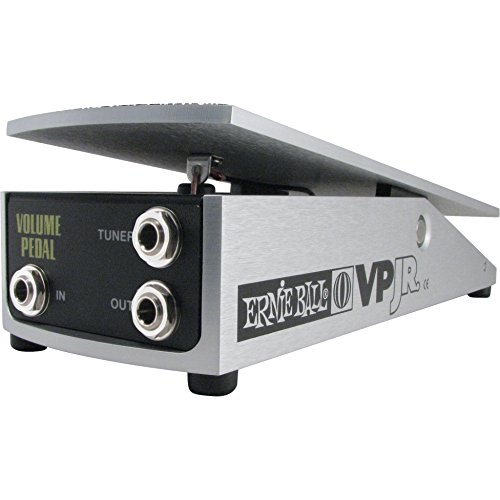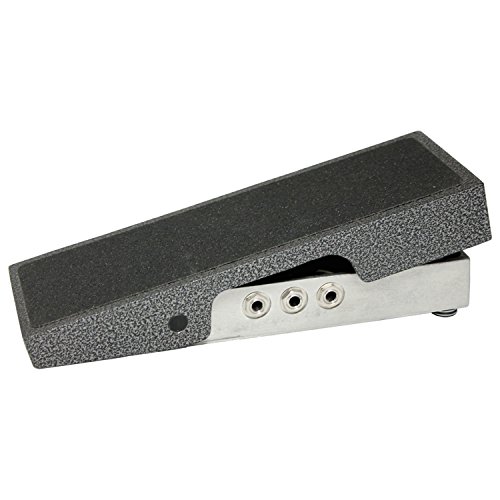10 Best Guitar Volume Pedals (2020 Reviews)
Controlling your guitar’s volume and adjusting its knobs on stage can be quite the hassle, but that’s where volume pedals come in. With so many different volume pedals of different sizes, shapes, and functionalities, we know it can be quite hard to choose the right one for your pedalboard.
That’s why we’ve researched and made this list of the 10 best volume pedals that you can buy today, along with a buying guide.
Top Picks: 10 Best Volume Pedal Reviews
1. Ernie Ball VP Jr Guitar Tuner/Volume Pedal - Best Overall
Specifications
Size: 2.5” x 10” 3.5”
- Type: Active
- Material: Aluminium, Kevlar
- Impedance: 1M Ohm
Ernie Ball is a legendary name in the world of guitar, as they make some of the best guitar strings and accessories which are widely used by many famous artists. Their best volume pedals have been fan favorites for many years too, and the new Ernie Ball VP Jr Tuner is designed to carry on that legacy of being the best volume pedal for guitar, with a classic, versatile design that doubles as a fantastic tuner pedal too.
The Ernie Ball VP Jr has mono, ¼” input and output jacks on the front, along with two jacks for effects return and effects send. Since it has a high input impedance, it is designed to be at the beginning of your pedalboard’s signal chain, so it receives your guitar’s dry signal. The effects loop lets you attach effects to it that won’t be affected by the volume pedal, hence making it quite versatile. According to popular YouTuber Ryan ‘Fluff’ Bruce (1):
The Ernie Ball VP Jr. Tuner is a cool and fresh new pedal, with a fast and precise tuner and a very durable build.
What makes the Ernie Ball VP Jr Tuner so special is its touchscreen LCD display on the foot treadle, which has three modes: Volume + Tuner, Tuner only, Volume only, which can be set according to the way you need it. In the combined mode, it shows you the strength of your volume signal, from 0 at the heel to 10 at the toe-down position, and when it is at 0, it automatically switches to the tuner mode so you can tune your signal accurately, in any reference pitch from 432 Hz to 447 Hz.
If you’re looking for a fantastic volume pedal that also has a tuner built into it, you should definitely check out the Ernie Ball VP Jr Tuner pedal. With a smooth treadle that has a good grip and feel, a precise tuner and volume display, multiple connectivity jacks, a rugged aluminum design, and a high impedance, actively powered input with large headroom, the Ernie Ball is the best guitar volume pedal, doing everything a guitarist could need from one.
2. Donner 2 in 1 Viper Mini Passive Volume/Expression Guitar Effect Pedal - Budget Pick
Specifications
Size: 6” x 2.7” x 2.4”
- Type: Passive
- Material: Plastic
- Impedance: 100k Ohm
Donner produces some of the most affordable and reliable effects pedals and other musical equipment and accessories on the market. The Donner Viper Mini is a 2-in-1 pedal, designed to provide the functionality of either a volume pedal or an expression pedal as necessary in a very lightweight, compact pedal. It’s part of a range of compact pedals that Donner has released recently.
The Viper Mini has a very simple design, featuring mono, ¼” input and output jacks to connect your guitar and pedalboard too. The interesting feature here is that it automatically detects the output source, and hence operates as either a volume pedal or an expression pedal, based on its connection. Its analog circuitry and smooth taper allow you to control the parameters precisely and easily.
The pedal has a very compact and yet durable plastic build that can easily take some foot-stomping and fit on any pedalboard. Since it’s a passive pedal, it does not require any power source and works great as is. You can adjust the tension of the foot treadle the way you want it with a small screw as well.
If you’re looking for a simple volume pedal that can also function as an expression pedal on a budget, then the Donner Viper Mini is one of the best volume pedals at its price. With easy to use functionality, automatic output switching, smooth passive power, and a compact build, the Viper Mini gets the job done for an affordable price.
3. JOYO WAH-II MultiMode Volume/Wah Pedal - Most Versatile
Specifications
Size: 6.3” x 2.5” x 2.1”
- Type: Active
- Material: Metal
- Impedance: 2.2M Ohm
Joyo has been creating great-quality guitar effects and accessories for quite some time now, and hence their products have gained popularity. The Joyo Wah-II is part of a pair of new pedals they recently launched, and it functions as a fantastic and versatile wah-wah pedal as well as a volume pedal on a budget.
The Wah-II has a mono input and output jacks, and it functions on two modes: Wah/Bypass and Wah/Volume. To use it as a volume pedal, you have to use the second mode, wherein the footswitch will activate the volume function. You can use it as a standalone Wah pedal too, and the Wah is extremely customizable with two knobs for Q (width of the Wah), and range (frequency ranges), that adjust the filter and change its tonality.
The pedal is built with metal, so it’s durable, and its small footprint ensures that it can easily fit on your pedalboard. There’s a rubber grip on the foot treadle, and an LED indicator as well. The pedal is powered by a 9V power supply, so the active volume control ensures a stable, strong signal with no tone loss.
If you’re looking for a versatile volume pedal that includes a great Wah mode, the Joyo Wah-II is an amazing and affordable choice. With a highly customizable Wah tone, smooth and active volume control, and a compact design with an easy to use treadle, Joyo has made another great product for those that don’t want to spend too much on a volume/wah pedal.
4. Morley 20/20 Volume Plus Guitar Effect Pedal
Specifications
Size: 2.8” x 4.5” x 6.9”
- Type: Active
- Material: Steel
- Impedance: 100k Ohm
Morley has been innovating guitar effects for many decades now, and they also make some of the best volume pedals today. Instead of traditional potentiometer designs, they utilize optical circuitry which makes them more durable, noiseless, and smoother. The Morley Volume Plus is a part of their new 20/20 line of pedals, which feature many modern improvements for the discerning guitarist.
The Volume Plus has a mono input and a mono output jack to connect your guitar and amplifier. There’s a footswitch that turns on or off the minimum volume function, and there’s a knob to control its value. By controlling this value, you can go from deep, violin-like swells to short, tremolo effects and everything in between, letting you customize the pedal exactly as you want it. The audio taper is smooth, and the optical circuitry offers noiseless operation.
The pedal features a classic Morley design like the PVO+, with a steel plate on top of which there’s a foot treadle. They’ve made it more compact so it can easily fit on most pedalboards, and the treadle’s logo is glow-in-the-dark for easy navigation on dark stages. It’s an active pedal, so it requires a 9V battery or power supply, but it ensures a consistent signal.
If you’re looking for a great volume pedal with minimum volume control and optical circuitry, you should certainly consider the Morley 20/20 Volume Plus. It offers consistent, noise-free performance with a variety of different swell options, and it’s built to last for years, making it a valuable addition to any guitar player’s collection.
5. BOSS FV-30H
Specifications
Size: 2.3” x 3.2” x 7.6”
- Type: Passive
- Material: Die-cast Aluminum
- Impedance: High
Boss, a brand of the Japanese company Roland, is a famous name in the world of guitar effects pedals. Having been used by many famous artists around the world, Boss has now updated their earlier volume pedal designs with the new FV-30 series, which feature a smaller, sturdier design with modern upgrades and features.
The Boss FV-30 series has a very simple design, where the H is the high impedance variant, as it is designed to be connected directly to your guitar. Hence, it has a mono input and output jack, as well as a separate tuner output so you can connect your tuner pedal easily. The volume sweep is silky-smooth, and offers a natural response to your music playing, letting you adjust volume swiftly and effortlessly. According to Mitch Gallagher of Sweetwater Sound (2):
I love the size of these pedals and they fit very comfortably on a pedalboard, and they feel very comfortable to play under your foot.
This volume pedal features a classic Boss design, but it’s very compact so it can easily fit on most pedalboards. With the rugged aluminum chassis, it’s built to survive all the foot-stomping action you throw at it. As it’s a passive pedal, it works best with passive pickups and doesn’t need any power, and the foot treadle can be adjusted via a screw for smooth action. The L version (for low impedance) features stereo volume outputs as it can connect to effects pedals or even keyboards.
If you’re looking for a great volume pedal that’s compact and well-built, then you should consider the Boss FV-30H. It allows precise control over your guitar volume without sacrificing too much pedalboard space, and the tuner output makes it even more versatile. It’s one of the most simple, and yet best volume pedals that a guitar player may get today.
6. Jim Dunlop DVP4 Mini X Guitar Volume Pedal
Specifications
Size: 2.5” x 3” x 6”
- Type: Passive
- Material: Aluminum
- Impedance: 250K Ohm
Dunlop is a pretty famous name in the world of guitar effects and accessories, and their line-up of guitar volume pedals have been widely used by many artists. The Dunlop DVP4 volume pedal, their latest release, comes at a size almost half that of the older DVP3, with a lot of added functionality and more flexibility in order to function better as a volume pedal as well as an expression pedal.
There are three ¼” jacks on the DVP4 - Input, Output, and Aux. The Input jack is used to connect your guitar using an appropriate cable and the Output jack to an amplifier, when it is being used as a passive volume control pedal. The Aux jack can function as a tuner output, or can be used to connect an external pedal and be used to control its FX parameter as an expression pedal. There’s an internal trim pot that can be used to set its minimum volume (sensitivity) the way you need it, and the polarity can be reversed as well.
The DVP4 Mini X pedal is one of the smallest volume pedals, so it can be carried around wherever very easily, and also fit on most pedalboards. With different connectivity jacks, as well as a polarity switch and internal trim pot, it can work with a variety of different instruments and pedals easily, and the torque of the foot treadle can be adjusted using a screwdriver for smooth foot movement. It works best with passive pickups, and doesn’t require a power source.
If you’re looking for a really portable volume expression pedal, then the Jim Dunlop DVP4 is one of the best options. With a tiny form factor of just 2.5” x 3” x 6”, and amazing versatility packed into it with 3 connectivity jacks, adjustable foot tension, a lightweight and durable aluminum chassis, and functionality as both a volume and expression pedal, the DVP4 is simply a fantastic choice for professionals and amateurs alike.
7. Lehle Mono Volume Pedal
Specifications
Size: 2.6” x 4” x 10.2”
- Type: Active
- Material: Aluminum
- Impedance: 2M Ohm
Lehle is a German company that manufactures boutique accessories for guitars, like volume pedals and switches. The Lehle Mono volume pedal is one of their best offerings, with a unique magnetic sensor control system that offers extremely smooth performance and a rugged, durable design that’s meant to last a lifetime.
The Mono Volume has a mono input jack, and two output jacks: a direct, tuner output and a volume output. The direct output lets you connect either a tuner or any other pedal, and will send a constant, buffered signal, whereas the volume output will be controlled by the foot treadle. This allows for a variety of different connection options, and you can even connect to two amps and blend your signal.
The Lehle Mono has a very hefty and sturdy all-metal chassis that can definitely survive a lot of foot-stomping. Due to its larger size, it may not fit on all pedalboards, but there is a variant called Mono 90 that has the jacks on the side instead of the front. With the gain control, you can get up to +10dB of boost, and there’s a very large headroom of 110dB available here.
If you’re looking for a unique volume pedal with a very smooth action, you should definitely consider the Lehle Mono Volume Pedal. With its magnetic sensors, it offers a buttery-smooth sweep, and it has a variety of connectivity options, gain control, a comfortable foot treadle, and a very durable build that makes it one of the best volume pedals and well-worth its high price.
8. BOSS FV-500H Volume Pedal
Specifications
Size: 2.9” x 4.4” x 11.4”
- Type: Passive
- Material: Aluminum
- Impedance: High
The second entry by Boss on this list, the FV-500 is one of their most popular volume pedals and have been used by famous artists for many years now. The FV-500H is the high impedance variant, which is designed to be connected to Hi-Z instruments like guitars (which have a strong signal), but it can even function as an expression pedal.
The FV-500H has four ¼” connection jacks for input, output, expression, and tuner output, respectively. Hence, you can not only control your guitar’s volume, but also use it as an expression pedal, and send a direct signal via the tuner output for accurate tunings. There’s a minimum volume knob that sets the minimum volume at heel-down position as well, so you can adjust the range precisely as you like it.
The Boss FV-500H has a superb build quality with a die-cast aluminum chassis that’s designed to handle whatever you throw at it. However, it is quite big and heavy, so it needs more space on your pedalboard. Since it’s passive, it requires no power source to function properly, works best with passive pickups, and you can even adjust the tension of the treadle to your liking. The L version even has stereo volume outputs for more versatility.
If you’re looking for a great, durable, and simple volume pedal from the legendary Boss, you should definitely check out the Boss FV-500H. It may be a slightly older model now, but it still maintains an excellent build quality with all the necessary connectivity, making it a great product for modern guitarists.
9. Ernie Ball VP Jr. P06180 250K Potentiometer for Passive Electronics
Specifications
Size: 2.4” x 3.5” x 10”
- Type: Passive
- Material: Stainless Steel
- Impedance: 250k Ohm
Another entry by Ernie Ball on this list, the VP Jr. 250k is a classic volume pedal that’s designed for passive instruments like guitars. It’s a simple pedal with a rugged, stainless steel construction that’s built to last and a high impedance to make sure that there’s no signal loss, making it a very easy-to-use pedal as well.
This model of the VP Jr. is much more compact compared to Ernie Ball’s older models, much like the VP Jr. Tuner we discussed earlier. There are three jacks for input, output, and tuner, so you can easily connect it with your existing pedalboard setup. For added versatility, there’s a Micro Taper switch that lets you choose between two different swell rates. Since it’s a passive pedal, it works best with passive pickups which produce higher impedance signals.
The VP Jr. 250K features a classic Ernie Ball design, with a rugged construction and a big foot pedal that’s very easy to grip and use comfortably. There’s a screw you can use to adjust the treadle tension, making it smooth the way you find comfortable. The cable is made of kevlar, ensuring a long life, and the pedal works without any power source since it’s passive.
If you’re looking for a simple, passive volume pedal that gets the job done well, then you should consider the Ernie Ball VP Jr. 250k. With different connectivity jacks that include a tuner output, a high-impedance circuitry, a classic Ernie Ball design that looks and feels premium, and the Micro Taper switch for changing the swell, the VP Jr. is a fantastically simple volume pedal.
10. Goodrich L-120 Low-Profile Volume Pedal Guitar
Specifications
Size: 10.8” x 2” x 2”
- Type: Passive
- Material: Aluminum
- Impedance: 470K Ohm
Goodrich is an American company that manufactures boutique guitar effects, most well-known for its series of volume pedals. The L-120 is a low-profile, passive volume pedal based on string actuators and a Goodrich 470k potentiometer that’s more compact than their other products, and offers amazingly smooth performance with a sturdy build.
The L-120 has three connection jacks for mono input, mono output, and a tuner output for direct connections. It’s a very straightforward pedal and very easy to operate, and it’s string actuation system provides really great performance with a well-balanced sweep that suits many styles of play. This volume pedal works amazingly well straight out of the box.
The volume pedal is built with forged aluminum, so it’s very rugged and durable, and it can easily survive a ton of foot-stomping. The foot treadle is heavy-duty and very easy to grip with a non-skid surface, and since it’s passive, it does not require any power source to function. If you’d like a taller, slightly bigger volume pedal, you can also consider the H-120 variant.
If you’re looking for a great low-profile volume pedal that simply works straight out of the box, you should take a look at the Goodrich L-120 volume pedal. With a fantastic build that’ll last for years, a smooth, balanced feel to it, and all the necessary connections, it’s a volume pedal that does its job well.
Buying Guide: How To Choose The Best Volume Pedal For You
If you’re still not sure about what’s the best volume pedal for you, then here are some essential tips and suggestions that you should keep in mind before buying your first volume pedal:
Type
Volume pedals are typically offered in two types: Passive and Active. Passive volume pedals do not require any power source, and hence you can connect them to an instrument and use them directly. An active volume pedal, however, requires an external power source (usually 9V), and so it will function only when provided with enough power; they also contain a buffer that can boost your signal’s gain and prevent any signal loss.
Passive volume pedals are generally less sensitive than active volume pedals, and may cause signal loss near the high-end as well.
A passive volume pedal contains a potentiometer, much like the knob on your guitar, that gradually rolls off the signal strength as you push it down. An active volume pedal has a small amplifier that acts as a buffer, so it makes your signal more even and smooth, resulting in a more sensitive sweep that responds well to dynamics. It also prevents any signal loss near the high frequencies, as they get amplified (3).
Impedance
The pedals on this list come with a wide range of different impedance values, and you may be wondering why that’s relevant to you. Impedance is the resistance offered by the pedal to the guitar signal, and it is very important in determining exactly where the pedal should go in your pedalboard and the chain of effects.
Low impedance volume pedals work best at the end of your signal chain, whereas high impedance ones should be at the beginning.
A high-impedance volume pedal should be connected directly to your guitar, with no buffers in between. This ensures that they’ll work correctly and not cause much signal loss, but it should be noted that if there are distortion pedals in front of the pedal, then the effect of the volume pedal is very low. For high-gain setups, a low-impedance volume pedal at the end of your chain is more beneficial, as it controls the overall output volume of your main signal, resulting in smoother sweeps.
Size And Material
When buying a volume pedal, you should be sure that it’ll fit nicely in your existing pedalboard and signal chain, and also be comfortable for you to use. Generally, guitar volume pedals come in a lot of different shapes and sizes, such as the Ernie Ball VP Jr., which has a large treadle and a comfortable sweep area, or the Dunlop DVP4, which is much smaller and can easily fit on most boards. Hence, pick one that’s comfortable and will also be easy for you to carry around.
Some of the pedals on this list are built with plastic to be more affordable, while others are made with metals like steel and aluminum. If you want a single long-lasting pedal that can survive for many years and be able to go on tours without getting damaged, we’d recommend getting a volume pedal with a metal chassis. But if you’re just beginning and you need to try one out, then you may pick a cheaper one as they function equally well.
FAQs
A volume pedal is used to control your guitar’s volume using your foot, offering a very convenient way of adjusting it during a live performance. When it’s connected directly to your guitar, it functions much like your guitar knob and adjusts the ‘input volume’ of the signal. But if you use a volume pedal at the end of your signal chain, it will control the overall output volume of your signal, resulting in smoother sweeps.
No, an expression pedal is not the same as a volume pedal. Expression pedals are used to control an FX parameter of another pedal, such as delay or reverb or even a modulation, whereas a volume pedal controls the signal strength coming into, whether it’s input volume from your guitar or output volume from another pedal. Some pedals may be able to perform both functions, but they are still separate.
You can put your volume pedal in several different places in your signal chain according to how you need it, but there are two common positions: a high impedance pedal connected directly to your guitar (which controls input volume), or a low impedance one at the end of the chain (to control overall volume).
Mark Knopfler uses an Ernie Ball volume pedal, one of the original models from the 1970s, and still one of the best volume pedals for guitar. If you’d like to achieve a similar tone, you can use a volume pedal from the VP Jr. lineup of pedals as they are very similar in tone and feel, and will provide a similar performance if used appropriately.
References
- The Ernie Ball VP Jr Tuner Pedal!. Retrieved from: https://www.youtube.com/watch?v=Ww0lDJPDqfg
- BOSS FV-30H and FV-30L Volume Pedals Review by Sweetwater Sound. Retrieved from: https://youtu.be/Y-mkfYZIM00?t=255
- Volume Pedal Q&A. Retrieved from: https://missionengineering.com/volume-pedal-qa/

